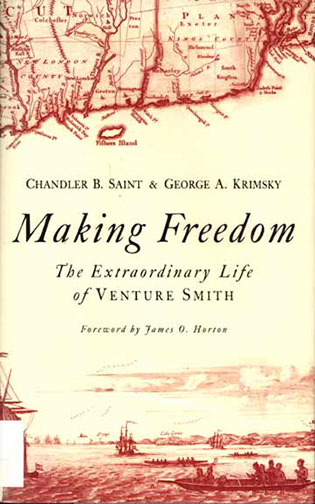
Home Structural Products & Services, Stairlifts
Structural Products & Services, Stairlifts
Furniture, Clocks,
Accessories
Antiques, Folk Art,
Fine Art, Auction Houses
BREAKING CHAINS
A Review of MAKING FREEDOM: The Extraordinary Life of Venture Smith by Chandler B. Saint and George A. Krimsky, with a Foreword by James O. Horton, Wesleyan University Press, 2009
 |
“The law will never make men free: it is men who have got to make the law free. “So said Henry David Thoreau in “Slavery in Massachusetts,” a speech he delivered in 1854. It is man’s responsibility to exercise the moral/imaginative, making/changing instinct that underlies official law. One part reason, one part feeling, and one part historical memory – call it historical scope if you will – it is, in the final analysis, our source of practical hope for the future. It is this kind of spirit that is evoked in this book. Of the millions who have seen “Twelve Years a Slave,” there is a percentage, largely younger people, for whom the film was something more than entertainment. These people, whatever their age, who feel moved to learn and understand more about the twisted history of race relations in America, these people should go on the computer and get themselves a copy of MAKING FREEDOM. |
| This is a story of a side of slavery that hasn’t been written about much-- slavery in New England in the years leading up to the Revolutionary War. Venture Smith was the name given in America to an African prince who was captured by a rival tribe in Ghana and sold to slave-traders when he was ten years old, in 1738 or 1739. Sold into slavery in Rhode Island, he married fellow slave Meg in 1754, with whom he had a daughter, Hannah and two sons, Solomon and Cuff. |
Shortly after his daughter was born, Venture was sold to Thomas Stanton of Stonington ,Connecticut, who bought Meg and Hannah two years later. Venture was sold for the last time in 1761 to Oliver Smith, Jr., also in Stonington, who agreed to let Venture purchase himself for 85 pounds, to be paid in installments. It took Venture Smith nearly five years of making payments to buy his freedom, largely with money Smith allowed him to keep from side jobs. Eight years later, Venture bought his wife’s freedom. From then until his death in 1805, pushing back against a world of prejudice, Venture Smith did better for himself and his family than most whites, buying and selling various pieces of land in Connecticut and Long Island, finally settling down and building a house on a good-sized farm at Haddam Neck on the Connecticut River. What makes this book so uplifting is the firm grip noted antiquarian Saint and accomplished journalist Krimsky together have on an historically-rooted, realistic idealism whose implications are as much about facing the problems of the present and the future as they are about understanding the past.
There is no wasted space in this book. In the Foreword, George Washington University history professor James O. Horton stirs the pot by bringing up Abigail Adam’s letter to husband John in 1774 in which she points out that “It always appeared a most iniquitous scheme to me to fight ourselves for what we are daily robbing and plundering from those who have as good a right to freedom as we have.” And this comes five pages before the “Introduction”! Did you know that there were over 6,000 slaves in Connecticut as the Revolution approached, more than any other state in New England? And did you know that two of the most popular items Connecticut farms shipped south at this time were ice and trotting horses? These are just two of the things I learned from this book.
In 1798,Venture Smith dictated his life story to schoolteacher Elisha Niles. It was published as a pamphlet that same year by The Bee in New London, Connecticut. A facsimile of this amazing document is reproduced at the end of the book, which is illustrated throughout with visual treasures, particularly reproductions of period landscape drawings by J. W. Barber.
Header photo by Skip Broom, HP Broom Housewright, Inc.